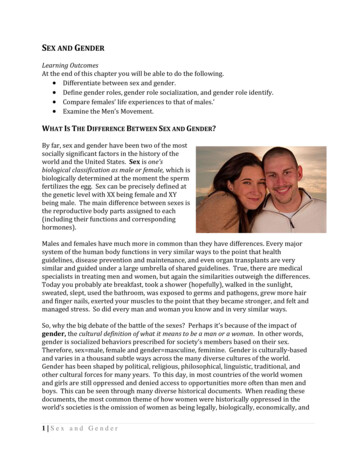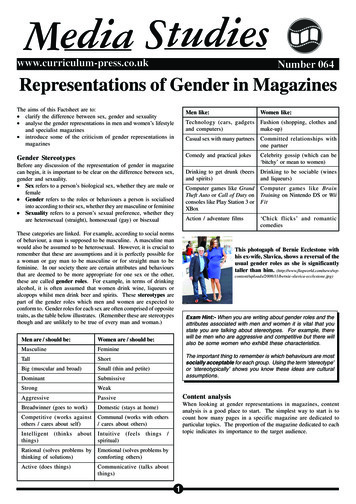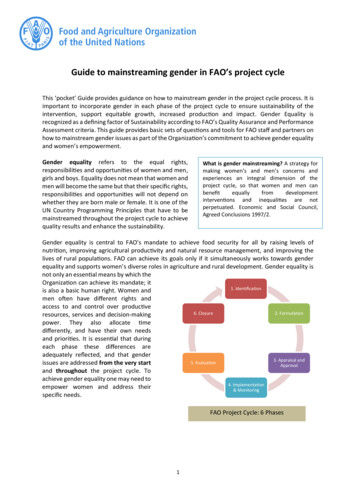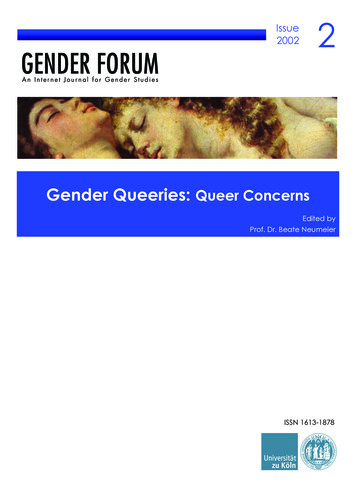
Transcription
GUIDELINE 2014UNAIDS GENDER ASSESSMENT TOOLTowards a gender-transformative HIV response
UNAIDS / JC2543/1/E (English original, May 2014)ISBN 978-92-9253-042-6Copyright 2014.Joint United Nations Programme on HIV/AIDS (UNAIDS).All rights reserved. Publications produced by UNAIDS can be obtained from the UNAIDS InformationProduction Unit.Reproduction of graphs, charts, maps and partial text is granted for educational, not-for-profit andcommercial purposes as long as proper credit is granted to UNAIDS: UNAIDS year. For photos, creditmust appear as: UNAIDS/name of photographer year. Reproduction permission or translation-relatedrequests—whether for sale or for non-commercial distribution—should be addressed to the InformationProduction Unit by e-mail at: publicationpermissions@unaids.org.The designations employed and the presentation of the material in this publication do not imply theexpression of any opinion whatsoever on the part of UNAIDS concerning the legal status of any country,territory, city or area or of its authorities, or concerning the delimitation of its frontiers or boundaries.UNAIDS does not warrant that the information published in this publication is complete and correct andshall not be liable for any damages incurred as a result of its use.Unless otherwise indicated photographs used in this document are used for illustrative purposes only.Unless indicated, any person depicted in the document is a “model”, and use of the photographdoes not indicate endorsement by the model of the content of this document nor is there any relationbetween the model and any of the topics covered in this document.
TABLE OF CONTENTSINTRODUCTION 3CONCEPTUAL FRAMEWORK 4STAGE 1 5Preparing for the gender assessment of the national HIV responseSTAGE 2 10Knowing the national HIV epidemic and contextSTAGE 3 15Knowing the national HIV responseSTAGE 4 28Analysing and using the findings of the gender assessment fora gender-transformative HIV responseANNEX A 31Gender equality and HIV: Resources and links to tools and guidanceANNEX B 33Model Terms of Reference for the country assessment team supportingthe undertaking of the gender assessment of the national HIV responseANNEX C 35Terms of Reference for consultancy for the undertaking of a genderassessment of the national HIV responseANNEX D 37Gender Assessment Sample Workshop AgendaANNEX E Guiding terminology39
ACRONYMSAIDSacquired immunodeficiency syndromeARTantiretroviral therapyCCMCountry Coordinating MechanismCEDAWConvention on the Elimination of All Forms of Discrimination against WomenCIDACanadian International Development AgencyDHSDemographic and Health Surveys ProgramGARPRGlobal AIDS response progress reportingGBVgender-based violenceGFATMGlobal Fund to Fight AIDS, Tuberculosis and MalariaGIPAGreater Involvement of People Living with HIV (Principle)HIVhuman immunodeficiency virusIECinformation, education and communicationIPVintimate partner violenceLBGTlesbian, bisexual, gay and transgenderMSMmen who have sex with menNSPnational strategic planPEPpost-exposure prophylaxisPEPFARUnited States President’s Emergency Plan for AIDS ReliefPrePpre-exposure prophylaxisRSTregional support teamSRHRsexual and reproductive health and rightsUNAIDSJoint United Nations Programme on HIV/AIDSUNDAFUnited Nations Development Assistance FrameworkUNDPUnited Nations Development ProgrammeUNFPAUnited Nations Population FundUN WOMENUnited Nations Entity for Gender Equality and the Empowerment of WomenUSAIDUnited States Aid Development AgencyWCAWest and Central AfricaWHOWorld Health Organization2UNAIDS GENDER ASSESSMENT TOOL: Towards a gender transformative HIV response
INTRODUCTIONLaunched in 2010, the UNAIDS Agenda for accelerated country action for women, girls, gender equality and HIV2010–2014 (hereinafter, the Agenda) presents a menu of strategic actions to better respond to the needs anduphold the rights of women and girls within HIV responses.1 Structured around three recommendations, theAgenda’s focus is on country-level implementation.2 A mid-term review of the Agenda, presented to UNAIDSBoard in December 2012, revealed that a more systematic approach to data collection is needed for evidencebased planning and budgeting for gender-transformative HIV responses.As such, UNAIDS Secretariat led a consultative, multi-stakeholder process to develop a gender assessment toolto facilitate the undertaking of gender assessment processes. Led by national stakeholders and partners, genderassessment processes are comprehensive initiatives that set out to identify the needs of women and girls inall their diversity and in the context of HIV at the country level. They then use the information compiled andanalysed to elaborate and review strategic planning processes, increase the capacity of women’s organizations, andleverage political commitment to address these needs.The Gender assessment tool for national HIV responses (hereinafter the Tool) is intended to assist countries assesstheir HIV epidemic, context and response from a gender perspective, helping them to make their HIV responsesgender transformative and (as such) more effective. The Tool is specifically designed to support the developmentor review of national strategic plans (NSP) and to inform submissions to both country investment cases and theGlobal Fund to Fight AIDS, Tuberculosis and Malaria (GFATM).The Tool also enables the integration of gender equality in other strategic processes—such as the United NationsDevelopment Assistance Framework (UNDAF)—and it serves as a tool for technical capacity building fornational authorities, civil society organizations and key stakeholders. By doing so, the Gender assessment toolsupports the roll-out of the UNAIDS Agenda. This will be a valuable tool for stakeholders who may have theirown requirements for gender analysis (e.g. PEPFAR countries now are all required to complete a gender analysis).The Tool was developed through a robust process, guided by a multi-partner and multi-level reference group.Before it was finalized, the Tool underwent testing in different settings. UNAIDS partnered with Gestos— HIV,Communication and Gender, a Brazil-based non-governmental organization—to pilot the Gender assessmenttool in five countries across five different regions.3 This resulted in valuable lessons learned, including the Tool’sapplicability in diverse contexts, and it reaffirmed the critical importance of leveraging diverse multi-stakeholderengagement, for country ownership as well as diversity in inputs.While different constituencies can take the lead in advocating for gender assessment, it is recommended that theactual assessment is undertaken through country leadership. This will ensure that outcomes are incorporated intorelevant national strategic 0100226 jc1794 agenda for accelerated countryaction en.pdfThe three recommendations in the Agenda are 1) generate and use evidence, 2) translate political commitments into action, and 3 ) create anenabling environmentThe five countries were Plurinational State of Bolivia, Djibouti, Jamaica, Rwanda and Tajikistan.GENDER ASSESSMENT TOOL: Towards a gender transformative HIV response UNAIDS3
CONCEPTUAL FRAMEWORKThe Gender assessment tool makes use of a number of terms common to the HIV and gender responses. It seeksto move the HIV response along the continuum from gender-blind to gender-sensitive, and ultimately to gendertransformative (see Table 1).When referring to gender, the formulation of the Tool is built upon the UNAIDS definition of gender as a sociallyconstructed set of norms, roles, behaviours, activities and attributes that a given society considers appropriate forwomen and men, with the inclusion of people who identify themselves as transgender. The intricacy of the issueexpands with the understanding of diverse gender identities, a person’s deeply felt internal and individual experienceof gender that may or may not correspond with the sex assigned at birth. Gender-based prejudice includes any kindof stigma, discrimination, or violence against somebody because of their gender identity or their sexual orientation.Table 1. Gender Integration SpectrumType of interventionImpactExampleGender-negative orgender-blindFails to acknowledge the different needs orrealities of women and men, girls and boys.Aggravates or reinforces existing genderinequalities and norms.Lack of disaggregated data because of afailure to acknowledge that programmes andpolicies have different effects on women andmen.Gender-sensitive orgender-responsiveRecognizes the distinct roles and contributions Cash transfer programme provides fundsof different people based on their gender;to families to keep girls in school as onetakes these differences into account andelement to reduce girls’ vulnerability to HIV.attempts to ensure that women or girlsequitably benefit from the intervention.Gender-transformativeExplicitly seeks to redefine and transformgender norms and relationships to redressexisting inequalities.Challenges and changes both sexualitynorms and uneven access to resources inorder to strengthen women’s ability to insiston condom use by their male sexual partners.Source: UNDP, 2014.To maximize gender-transformative responses, it is crucial to understand key populations. Within UNAIDSterminology, key populations are those most likely to be exposed to or transmit HIV (including people living withHIV). In most settings, men who have sex with men, transgender persons, people who inject drugs, sex workersand their clients, migrant workers, people in prison, women, and sero-negative partners in sero-discordantcouples are at higher risk of exposure to HIV than other people. When performing the gender assessment, eachcountry should identify and invite the specific populations that are key to their epidemic and response basedon the epidemiological and social context—the engagement of these populations is crucial to a successful HIVresponse and for the gender assessment itself.For further information and clarification regarding key terminology used throughout this tool, please refer toAnnex E, as well as UNAIDS terminology guidelines.4In terms of the conceptual framework, the Tool forms part of a comprehensive approach to gender-transformativeHIV responses. A list of complementary resources and documents designed to support countries in engenderingtheir HIV responses at all stages can be found in Annex A.44See name,63629,en.asp, accessed 1 April 2014.UNAIDS GENDER ASSESSMENT TOOL: Towards a gender transformative HIV response
STAGE 1Preparing for the gender assessment of the national HIV responseThis stage provides guidance for preparatory work towards guaranteeing the quality of the gender assessment process and the resulting content indicating the necessary steps.Step 1 SECURE HIGH-LEVEL COMMITMENTHigh-level national commitment to fostering the inclusion of gender in the HIV response is key to the successfulundertaking of the gender assessment of a national HIV response. Dedicated steps need to be taken to ensurehigh-level commitment and to guarantee national leadership and ownership of the gender assessment.In order to reach high-level agreement on the undertaking of the gender assessment, the following steps might beconsidered by the lead organization and key government representatives.Task 1.1. Map out the key government decision-makers for the undertaking of a gender assessment that willinform the national HIV response.Task 1.2. Identify challenges and opportunities for building high-level support and prepare strategies to securethis support.Task 1.3. Prepare a brief one-page concept note on why it is important to undertake a gender assessment and howthat assessment will enhance the effectiveness of the national HIV response. Share the concept note, along withspecific information about the Tool, with key decision-makers.Step 2 ESTABLISH A GENDER ASSESSMENT TEAMThe most important step in securing a proper division of labour for the gender assessment is the composition ofthe core gender assessment team (see Annex B). Typically, a consultant also is engaged in order to support thecoordination and undertaking of the gender assessment (see Annex C).2.1 Establish a core gender assessment team comprised of the following: experts on HIV, gender policies and services; key government representatives, particularly national AIDS authorities, the Ministry of Health and theMinistry of Gender; relevant bi-lateral donors; representatives of civil society, including individuals from the network of women living with HIV and thewomen rights movement; and the UN.The members of the core gender assessment team should be influential leaders in the field of HIV and gender,nationally recognized for their expertise and result-based professionalism. The core team should preferably belimited to five to seven members; this will ensure meaningful engagement of all members and facilitate timelydecision-making and action.Note that it is very important not only to ensure country ownership and leadership, but also to engage a diverserange of stakeholders.GENDER ASSESSMENT TOOL: Towards a gender transformative HIV response UNAIDS5
Observation: In keeping with the principle of Greater Involvement of People Living with HIV (GIPA), themeaningful engagement of people living with HIV should be ensured.2.2 Bring the identified members together to share and review the terms of reference of the gender assessmentteam. At the same time, agree on roles and responsibilities of the core gender assessment team.2.3 Agree on how internal communication between the members of the gender assessment team will occur.Step 3 DEVELOP A GENDER ASSESSMENT FRAMEWORK3.1 Request that all members of the gender assessment team read the Gender assessment tool. Any questionregarding the Tool should be addressed and clarified prior to data collection.3.2 Discuss the goal of the gender assessment within the team, and clarify how it aligns with the concept note ofthe gender assessment.3.3 Agree on the objectives of the gender assessment, aiming for clear short-term results in support of the overarching goal.3.4 Agree on guiding principles for undertaking the gender assessment process, as well as ways to monitor theirapplication. In line with the UNAIDS Agenda for women and girls, such principles include: engagement of men and boys; ethical responses based on equity and fairness; evidence-informed approach; human rights-based approach; impartiality; meaningful participation of women and girls; partnership with civil society, including people living with HIV and other key affected populations; strategic and forward-looking approach; strong and courageous leadership; and transparency.3.5 Review and agree on the root concepts of the assessment, such as what is meant by “gender”, “key population”, “marginalized population”, and “populations vulnerable to HIV”, using agreed UNAIDS terminology as thestarting point.3.6 Identify the relevant stakeholders and experts who should be engaged in the gender assessment. The stakeholders should include government, civil society representatives, relevant bi-lateral agencies, and UN agencies. Asappropriate, also include stakeholders from key sectors, including health, education, gender, justice, human rightsand finance.Observation: In keeping with the principle of Greater Involvement of People Living with HIV (GIPA), the meaningful engagement of people living with HIV should be ensured. Civil society organizations working on gender,6UNAIDS GENDER ASSESSMENT TOOL: Towards a gender transformative HIV response
women’s rights, youth, key populations, and sexual and reproductive rights also must be engaged in the genderassessment.3.7 Define communication approaches to raise awareness with stakeholders beyond the gender assessment teamregarding the undertaking of the gender assessment.a) Identify key external stakeholders and partners who should be informed of the gender assessment as part ofensuring their support for the overall process and follow-up. This group of stakeholders differs from those in theprevious step, in that the stakeholders in step 3.6 will be actively engaged in carrying out the gender analysis,while the stakeholders in this step (3.7) are the broader group of partners that should kept apprised throughoutthe gender analysis process of its purpose, progress, outputs, and actions.b) Develop targeted advocacy messaging based on the need to undertake a gender assessment of the national HIVresponse. This messaging should outline how the gender assessment will support existing national processes andbe aligned with the HIV investment framework.c) Disseminate the messages. Decide who will be responsible for external communication to reinforce politicalcommitment and buy-in of stakeholders.d) Summarize the above steps in a brief communication road map.3.8 Define a clear, feasible and achievable timeline to prepare and undertake the gender assessment, includingmilestones and deadlines.Deadlines should be determined in such a way that the gender assessment will be completed in time for thefindings to be used in support of relevant national processes and opportunities.Agree on monitoring mechanisms for undertaking the gender assessment (as per the developed timeline).Step 4 DEVELOP A RESOURCE PLAN FOR THE GENDER ASSESSMENT4.1 List and agree on the human resources that will be needed to conduct the gender assessment—includingconsultants and assistants—and their respective responsibilities in the process.4.2 Prepare a budget for the undertaking of the gender assessment, and determine the cost of the followingrequirements: administrative expenditures; communication (including dissemination of the findings); human resources for the systematization analysis and communication of sex disaggregated and gender-based data; meetings and workshops (including lodging, travel and logistic costs, as needed); and other costs, as relevant to the national context.4.3 Confirm the availability of funds to support the gender assessment, or prepare a proposal that can be used tomobilize necessary resources from prospective donors.GENDER ASSESSMENT TOOL: Towards a gender transformative HIV response UNAIDS7
Note that the Country Coordinating Mechanism (CCM) can request the Global Fund Secretariat support theundertaking of the gender assessment with the CCM funding, or it can apply for specific technical assistancefunding from the Technical Assistance partners.5Step 5 COLLECT, COLLATE AND STORE RELEVANT DOCUMENTSPlease collect documents that that will inform the gender assessment in your country.1. Country specific data:a. relevant HIV data that is age and sex disaggregated; andb. additional data sources for gender issues linked to HIV (DHS domestic violence module, Violence againstChildren surveys, etc.).2. Global tools: members of the gender assessment team also should familiarize themselves with the availableonline tools. Refer to Annex A for a list of available resources.5.1 Review the list of documents—which should be prepared by the consultant—to ensure it is complete andappropriate.Review and add other documents that are considered relevant, including international and regional documents ofwhich the country is signatory, or documents that are important to the specific national context.5.2 Agree on a digital storage method for the documents (e.g. Drop Box, blog, cloud servers, etc.). The chosenmethod should allow team members to have common access.5.3 Share a list of all compiled documents with the stakeholders and partners for their review and input before thegender assessment workshop. These documents will form the basis for Stages 2 and 3.5.4 Familiarize yourself with online tools and guidelines for preparing to identify effective, evidence-basedinterventions. These tools will be crucial when the group identifies key interventions in Stage 4.Step 6 ORGANIZE A GENDER ASSESSMENT WORKSHOP WITH ALL RELEVANTSTAKEHOLDERSOrganize a gender assessment workshop with all relevant stakeholders in order to undertake Stages 2, 3 and 4 ofthe Gender assessment tool.The national level workshop preferably should take place over a period of two to three days (see Annex D for asample agenda for a gender assessment workshop).58An information note developed by the Global Fund and the Global Coalition on Women and AIDS (GCWA) on how to ensure that the NewFunding Model concept note responds to the gender dimensions of HIV can be found at guid af728b92-240f-4965-90e2-00707ddaeaa9&disposition inline (accessed 27 March 2014).UNAIDS GENDER ASSESSMENT TOOL: Towards a gender transformative HIV response
The participants should be drawn from different constituencies, including government, bi-lateral donors, UNagencies, academia and civil society. This ensures a wide range of perspectives that will enrich the discussion andreflection on Stages 2 and 3 of this Tool.The workshop also includes the identification of strategic interventions to address the issues and gaps identifiedby the gender assessment, and to inform the move towards a gender-transformative HIV response in the country.GENDER ASSESSMENT TOOL: Towards a gender transformative HIV response UNAIDS9
STAGE 2Knowing the national HIV epidemic and contextThis stage provides key questions for understanding the HIV epidemic from a gender perspective, thecontext surrounding behaviour, and any relevant socio-economic, political and economic factors. It providesimportant questions for assessing gender, such as asking about meaningful participation of women and girlsand key populations.It is recommended that the sections below be pre-populated with the relevant data when preparing for thegender assessment workshop.Step 7 HIV PREVALENCE, INCIDENCE AND BEHAVIOURAL INFORMATIONQuestion 1. What is the latest prevalence rate of HIV, disaggregated by sex and age, in the general population?1.1 Please specify the trend over time in prevalence data (disaggregated by sex and age).Observation: Consider presenting the trend (if it is available) in a graph in an annex.Question 2. What is the latest national HIV incidence rate, disaggregated by sex and age, in the generalpopulation?Question 3. Have population size estimations been performed for key populations?6Question 4. What is the prevalence rate of HIV in key populations (disaggregated by sex and age, if available)?4.1 Please specify the trend over time in prevalence data in key populations (disaggregated by sex and age).Observation: Consider presenting the trend (if it is available) in a graph in an annex.Question 5. If a modes of transmission study has been undertaken, what are the modes of HIV transmission forwomen, girls, men, boys and transgender persons? 7Question 6. Are there any locations of higher incidence of HIV (e.g. rural, urban or specific geographic locations)?Question 7. What percentage of young people aged 15–24 both correctly identify ways of preventing the sexualtransmission of HIV and reject major misconceptions about HIV transmission?8Provide information disaggregated by sex (female, male), age and transgender, if available.7.1 What percentage of young women, men and transgender people have knowledge of whether a person canreduce the risk of getting HIV by using a condom every time they have sex?67810See the “Special 2013 Global AIDS response progress reporting (GARPR) questionnaire” in Appendix 3 of UNAIDS Global AIDS responseprogress reporting 2013, Geneva, 2013: 108-09 ( available at s/documents/document/2013/GARPR 2013 guidelines en.pdf, accessed 27 March 2014).A modes of transmission study determines the way a given population acquires HIV (through sexual transmission, vertical transmission, use ofnon-sterile injecting equipment of infected blood transfusion) For more information, see UNAIDS, Modeling the expected short-term distributionof new HIV infections by modes of transmission, Geneva, 2012 (available from s/documents/document/2012/guidelines/JC2427 ModelingNewHIVInfectionsbyModesofTransmission en.pdf, accessed 27 March 2014).See Global AIDS response progress reporting 2013, Section 1.1., pp. 24–6 (available from s/documents/document/2013/GARPR 2013 guidelines en.pdf, accessed 27 March 2014).UNAIDS GENDER ASSESSMENT TOOL: Towards a gender transformative HIV response
7.2 If available, what is the trend in knowledge and access (disaggregated by sex and age) over the past five to10 years?Observation: Consider presenting the trend (if it is available) in a graph in an annex.Question 8. What is the percentage of women and men aged 15–49 who have had sexual intercourse with morethan one partner in the past 12 months?8.1 What percentage of women and men aged 15–49 who have had more than one partner in the past 12 monthsused a condom during their last incident of sexual intercourse?98.2 If available, what is the trend in knowledge and access (disaggregated by sex and age) over the past five to10 years?Observation: Consider presenting the trend (if it is available) in a graph in an annex.Question 9. Does the country have data on unwanted pregnancy among unmarried adolescents?9.1 Do the country policies and programmes link prevention of unwanted pregnancies and HIV prevention?Question 10. Is data available on intimate partner violence (IPV)?Is data available on sexual violence? If yes, please describe and include age disaggregated data (if possible).Question 11. Has the country collected data on stigma and discrimination toward people living with HIV (e.g.through the stigma index).10Please include data disaggregated by sex and age, where available.You have now reached the end of Step 7.Please review and analyse the data gathered above. In a limited set of bullets, identify gender differences andsummarize key issues based on the HIV epidemic data available. This data will be used later in the documentfor the analysis matrix.Step 8 SOCIAL, CULTURAL AND ECONOMIC FACTORSWhen answering the questions below, please refer to women, men and transgender people, disaggregated by age(if possible).Question 1. What socio-cultural norms and practices may contribute to increased risk of HIV transmissionamong women and girls, men and boys, and transgender persons?1.1 In what way do these socio-cultural norms and practices contribute to a higher risk of HIV transmission? Bespecific, based on evidence.See Global AIDS response progress reporting 2013, Section 1.4, pp. 28–9 (available from s/documents/document/2013/GARPR 2013 guidelines en.pdf, accessed 27 March 2014).10 The People living with HIV stigma index provides a tool that measures and detects changing trends in relation to stigma and discrimination experienced by people living with HIV. More information can be found at www.stigmaindex.org.9GENDER ASSESSMENT TOOL: Towards a gender transformative HIV response UNAIDS11
1.2 Does the country have any data on age-disparate sexual relationships between older men and youngerwomen? Also add any data on age-disparate sexual relationships between older men and younger men, if it isavailable.Question 2. Are there socio-cultural norms and practices that contribute to the risk of HIV transmission amongkey populations that were not named in Question 1? If so, what are these norms and practices, and what populations do they affect?2.1 In what way do these socio-cultural norms and practices contribute to a higher risk of HIV transmission? Bespecific by population, based on evidence.Question 3. What socio-cultural norms and practices may contribute to gender differences in any of the issuesdescribed in the answers you provided for Question 2 (e.g. knowledge, condom use, stigma, discrimination, earlyor unwanted pregnancy)?3.1 In what way do these socio-cultural norms and practices contribute to a higher risk of HIV transmission? Bespecific by population, based on evidence.Question 4. According to available data, what are the factors or social determinants—such as economic vulnerability, multiple sexual partners, or alcohol or chemical dependence—that contribute to the continuation of thesepractices and behaviours? Please identify factors for a) individual, b) community and c) society levels.You have now reached the end of Step 8. Please proceed to Step 9. After that is complete, you will be asked toanalyse the two steps together.Step 9 LEGAL AND POLITICAL FACTORSQuestion 1. Is there any legal framework or policy that may directly impact women and girls, men and boys, andkey populations in relation to HIV? If so, what aspect of their lives may be affected?If so, what aspect of their lives may be affected? Please tick the relevant boxes. criminalization of drug use criminalization of HIV transmission or exposure (including vertical (mother–to–child) transmission) criminalization of sexual orientation and/or gender identity criminalization of sex work denial of access to condoms or sexual and reproductive health services for young people (younger than18 years of age) denial of comprehensive sexuality education for young people (younger than 18 years of age) denial of inheritance and/or property rights to women early and forced child marriage practices HIV-related travel restrictions non-recognition of sexual or gender-based violence within marriage polygamous marriages12UNAIDS GENDER ASSESSMENT TOOL: Towards a gender transformative HIV response
Add others, as relevant, and please elaborate.Question 2. Are there legal frameworks that specifically protec
4 UNIS GENDER ASSESSMENT TOOL: Towards a gender transformative HIV response The Gender assessment tool makes use of a number of terms common to the HIV and gender responses.It seeks to move the HIV response along the continuum from gender-blind to gender-sensitive, and ultimately to gender-transform










